December 13th, 2006
Marquis de Portago, The Legend
By Ed McDonough
Review by Pete Vack
$79.00 US Approx.
Hardbound, 9 x 11 inches, 195 pages, Color and B&W photographs
Published by Mercian Manuals Ltd. 353 Kenilworth Road, Basil Common, Coventry, CV7 7DL, England Tel:01676 533304
ISBN 1-903088-27-5
Order from Mercian Manuals
Portago biography is our Book of the Year
By the time we got to know much about the Marquis de Portago he was dead.
News traveled much slower in 1957. The August issue of Sports Cars Illustrated arrived in our mailbox in late July. The Mille Miglia was featured in that unforgettable issue, as was the Portago Portrait, by Ken W. Purdy.
It was the most incisive, in depth personality article ever published in that, or any other motoring magazine in the United States and made Portago a legendary figure. Revised right before presstime, Purdy�s article became an epitaph, for by July, both the Mille Miglia and a Spanish Grandee named Alfonso de Portago had been dead for three months.
A posthumous hero
In pondering his death, Purdy articulated what Portago was all about:
Portago was not a great racing driver, although it is certain that he would have been, had he lived�He was not an artist, he left nothing of beauty behind him and nothing of use to the world. He moved no mountains, wrote no books, bridged no rivers. He saved no lives, indeed, he took innocents with him to his death�
Yet it would be a flinty heart which did not mourn his death. At the very least, he was an adornment in the world, an excitement, a pillar of fire in the night, producing no useful heat or light, but a glory to see nonetheless. At most he was an inspiration�for he proved that if anything at all is meant for us, we are meant to live life��
Ken Purdy, along with Hans Tanner, writing for Motor Sport, and New York Times reporter Robert Daley, created a cult figure whose impact was far greater than the sum of his accomplishments might suggest.
The short, sweet life of Alfonso de Portago
The son of a Spanish nobleman and a strong willed, English woman who had inherited the fortune of HFC founder Frank Mackey, Portago was not only born to wealth and entitlement, but was fiercely competitive and a superb athlete.
Up to the age of 24, his passion was horses, flat track and jumping. He quickly became one of the most successful amateur jockeys in Europe. Auto racing bit him in 1953-54, and he bought himself the proper sportscars (Maserati, OSCA and Ferraris) gaining entry into international events where he attracted the attention of the factory teams. By 1956 Portago was on the Ferrari Formula One team, entrusted with one of the Lancia Ferrari D50s. He fared well and for 1957 there was to be more opportunity, a chance cut short by his death, and that of 15 others in the Mille Miglia.
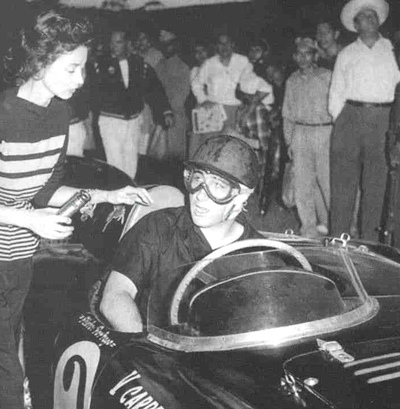
Portago bought the Ferrari 735 Sport Scaglietti 0428M, and hand painted it black. The start of the 1954 Mexican Road Race.
|
The legend lived on, as they so often do. In a scant four years, Fon de Portago had come from nowhere to the top of the heap, gaining the respect of his peers, an acknowledged force to be reckoned with. In the meantime, Portago had also gained fame bobsledding at Cortina, creating a Spanish team for the Olympics. Even more than other drivers, Portago was famous for his many affairs with beautiful actresses; as Sir Stirling Moss remarked in the Foreward, writing of the 1956 Tour De France in which he shared a Merceded Benz with George Houel, �Now George was a good crumpet chaser, but Portago really had that department all sorted out.�
After his death, Fon Portago was able to rest in relative peace for the next half century, despite several new articles, one by Brock Yates for Car & Driver, in 1986 and another by Doug Nye for Classic and SportsCar in 1985. They uncovered few new facts and in some cases added to the mystique and legends associated with Portago.
A deserved biography?
Some fifty years after Portago drove his first race car,
Ed McDonough decided that he would take on the task of writing the definitive Portago biography. He has done so with considerable authority and ability; there is little doubt that his work will stand, perhaps forever, as the final word on the subject. There was the question of whether a biography of someone like Portago was really viable--does this life deserve to be accorded a published biography. �It is the observer who has to judge the evidence and decide according to their own subjective criteria whether Portago deserves to be considered a legend.� wrote McDonough, and admits that he was more concerned about finding out about the reality of the man and his competency as a racing driver than in his status as a legend.
For many, Fon Portago was a boyhood hero in an age where masculine traits were more clearly defined. Portago demonstrated courage, sportsmanship, athletic ability, an intense desire to win, yet spoke four languages and was not adverse to reading books. Though he never had to work for a living, he succeeded in every field he entered. His attitude toward women was typically Latin and most certainly of the era, and yet women fell in love with him in bevies. It should not be surprising that such a person could influence a generation of young men interested in motor racing.
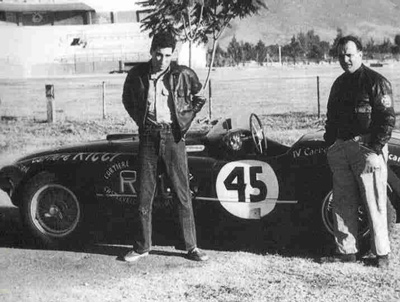
Chinetti, at right, and Portago at the 1953 Mexican Road Race. Portago served as ballast, it scared him badly but he decided to become a race driver anyway.
|
For young Luigi Chinetti Jr, Portago was not only a boyhood hero but a welcome houseguest. Of all the remarkable events to which Chinetti was privy to, his memories of Portago at the forefront. In an interview for VeloceToday, Chinetti related this story; �Portago spent some time at the shop, and at our apartment. He was a tremendous socialite as well as a great driver. Fon had this great presence, women adored him, and he was multi-lingual and very well educated.� It was Chinetti�s father who introduced Portago to the world of road racing, by asking him to accompany him in the 1953 Mexican Road Race.
McDonough was similarly impressed, and only 16 when Portago died. For McDonough, writing Portago�s biography was a labor of love, but would he find out our hero was less than expected? McDonough would uncover the layers, sift through the BS, and in the end, captured the essence of de Portago. And while he demolished a few myths in the process, the legend of Fon de Portago did not suffer unduly from the journalistic microscope.
Unprecedented access
McDonough�s credits are impressive, having authored �Sharknose Ferrari� and more recently �Alfa Romeo Tipo 33�. The key to the Portago biography was a stroke of luck that led to an unprecedented audience and lengthy interview with Portago�s American wife, Mrs. Carroll Petrie.
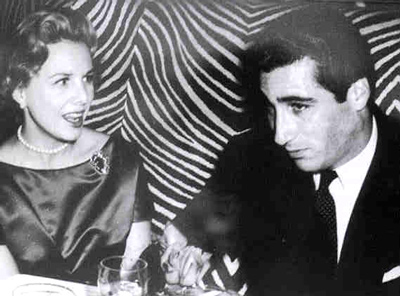
Portago enjoys a nightclub with his wife, Carroll.
|
This was augmented by another key individual, the New York Times reporter Robert Daley, who became interested in Portago at the Olympics. McDonough also tracked down Portago�s English roots, taking him to an English 17th century manor to talk to Portago�s cousin, Sir Michael Leighton Interviews with many drivers active in the 1950s, including Sir Stirling Moss, Roy Salvadori, Cliff Allison, and Roberto Mieres added depth and interest.
Up close and personal
McDonough also credited Terry O�Neil, who wrote �The Bahamas Speedweeks� with helping him nail down Portago�s activities there.
In our review of O�Neil�s book, we took aim at the fact that despite a great deal of research, O�Neil transported very little of the lives of the drivers who partied day and night on the Islands. Mr. McDonough, in turn, took us to task, supporting the O�Neill book and it�s scope. Yet much to his credit, with the Portago biography, McDonough has done a superb job in reporting on all aspects of a person�s life, not just the race results. McDonough vigorously brings Alfonso de Portago into full frame, making a person of the legend, and brings into focus the lives of the three women who loved Portago, all at the same time. In fact, McDonough has picked up where Purdy left off, writing an engaging story of a three dimensional person.
Track Record
Portago�s career as a horseman, once just based on speculation, is thoroughly investigated by McDonough, who with the help of both Carroll Petrie and horse racing historian John Randall filled in the gaps and set the record straight. Portago was in fact the �champion amateur rider of France� on two occasions, rather than a three time champion. Not a bad record, and his retirement at the age of 24 was prompted by weight gain, deadly for a jockey who was already 6 foot tall.
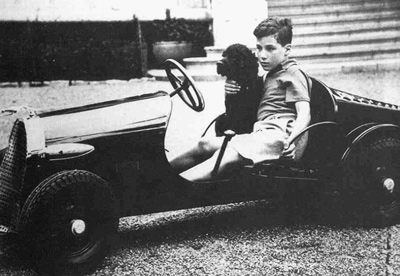
Portago at about the age of 6 with his gas powered race car. Credit Petrie Collection.
|
Finding a gold mine in the Portago family album still in the possession of Carroll Petrie, McDonough was able to determine how and when Portago actually began racing. The book features never before published photos of Portago behind the wheel of a toy Bugatti Type 35 (yes, the ones produced by the Bugatti factory), and a healthy looking gas powered car at the age of seven. After the war, Portago was found winning in midget racers in France. McDonough also found out that in 1954, Portago was driving a French Monomille, a formula car based on the Dyna Panhard.
From 1953 to the final Mille Miglia, McDonough sorts out every event in which Portago participated, and totals his successes in an appendix. In addition, most of the cars Portago owned or drove are given a sidebar, including the Maserati and OSCA he purchased in 1954.
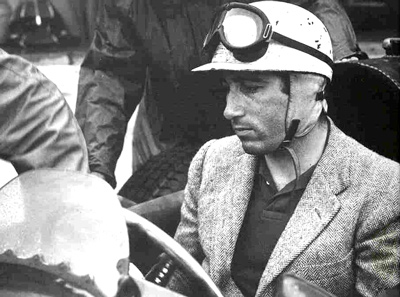
This shall be no more: A race driver who raced for the thrill, a gentleman who was extremely competitive, a nobleman who knew no boundaries.
|
Could we have done better?
Truly doubtful. The �Marquis de Portago� is a motoring book hard to beat. Granted, neither McDonough nor his peers including yrstrly are Pulitzer prize winning biographers, but he has managed to do a more than worthy job under difficult circumstances. A major fault in the book turned out not to be a mistake but instead a plan which didn�t work as well as it was hoped. Each chapter is preceded by a full size black and white shot of Portago, But they appeared to be a half tone which ran out of ink. McDonough says that�s his fault, it was intended to be a �ghostly� image.
There are niggling errors--the Alfa 6C2500 presumably owned by Portago is described as a Ghia but the photo illustration was a Pininfarina. The great primary source material should have been included in the bibliography as well as the Acknowledgements.
Finally, McDonough was not able to interview Portago�s sister Soledad, who might have been able to provide valuable insight into the life of her brother. Deadlines await, but that must have been a real frustration.

La Domenica del Corriere�s portrayal of the death of a Grandee.
|
Alfonso de Portago�s reputation and his legendary feats remain intact despite scrutiny, while McDonough�s reputation as one of the best motoring journalists in print is considerably enhanced by the publication of this book. Buy it. It is one hell of a Christmas present.
.



